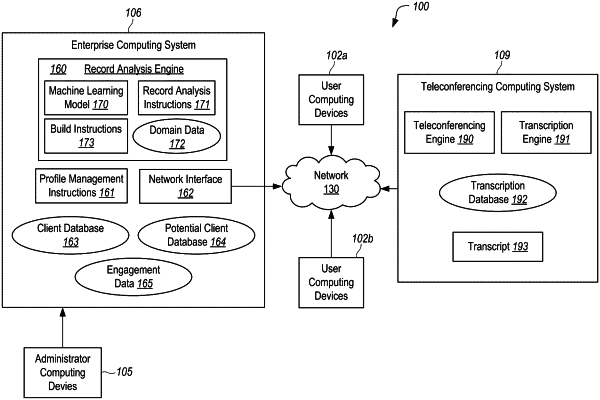| CPC G06F 40/30 (2020.01) [G06Q 10/083 (2013.01); G16H 20/10 (2018.01); G06N 20/00 (2019.01)] | 20 Claims |

|
1. A computer-implemented method, comprising:
establishing a programmatic connection comprising an application protocol interface (API), an app-specific protocol, or a parametrized HTTP call between a first computer and a second computer;
receiving, at the second computer from the first computer using the programmatic connection, a natural language transcript in electronic digital format of a conversation between a first party and a second party;
building a trained machine learning model by:
based on metadata stored with the transcript and specifying a language of the transcript, one or more identifications of the first party and/or the second party, one or more geographic locations of the first party and/or the second party, selecting a machine learning model having a particular machine learning type from among a FLARE model, a spaCY model, a BERT model, a RoBERTa model, or a ClinicalBERT model;
querying a database of domain data to select domain data comprising data elements are associated with healthcare or pharmaceuticals, based on the transcript and/or the parties or organizations within the transcript, the domain data comprising labeled conversation data of conversations using scientific, medical, and technical terminology in healthcare or pharmaceuticals and a taxonomy of sentiments, the domain data comprising a digitally stored data table storing a plurality of words or phrases and one or more associated scores that are unique to a category of emotional data; and
fine-tune training the machine learning model using the domain data to form the trained machine learning model to accept the natural language transcript as an input, predict or classify emotional content of one or more portions of the transcript related to the first party, and output a sentiment score, the sentiment score representing a likelihood of the first party to take an action;
accessing the trained machine learning model;
determining a first sentiment score related to the first party via inputting the natural language transcript into the trained machine learning model and evaluating the natural language transcript using single shot detection;
programmatically querying a digital engagement data database with an identification of the first party and receiving, in response, digital engagement data representing engagement of the first party with digital assets associated with the second party by the second computer programmatically via calls to a customer data platform querying a database of the customer data platform storing one or more of records, statistics, and metadata of conversations from contact center transcripts, chat data or chat transcripts, websites, or webinars collected over time;
evaluating, using a machine learning classifier, the first sentiment score and the digital engagement data to output a value indicative of the likelihood of the first party to take a particular action; and
determining whether the value is above a threshold, and if so, automatically sending to a computer device associated with the second party an order specifying shipping a product associated with the particular action to the first party.
|